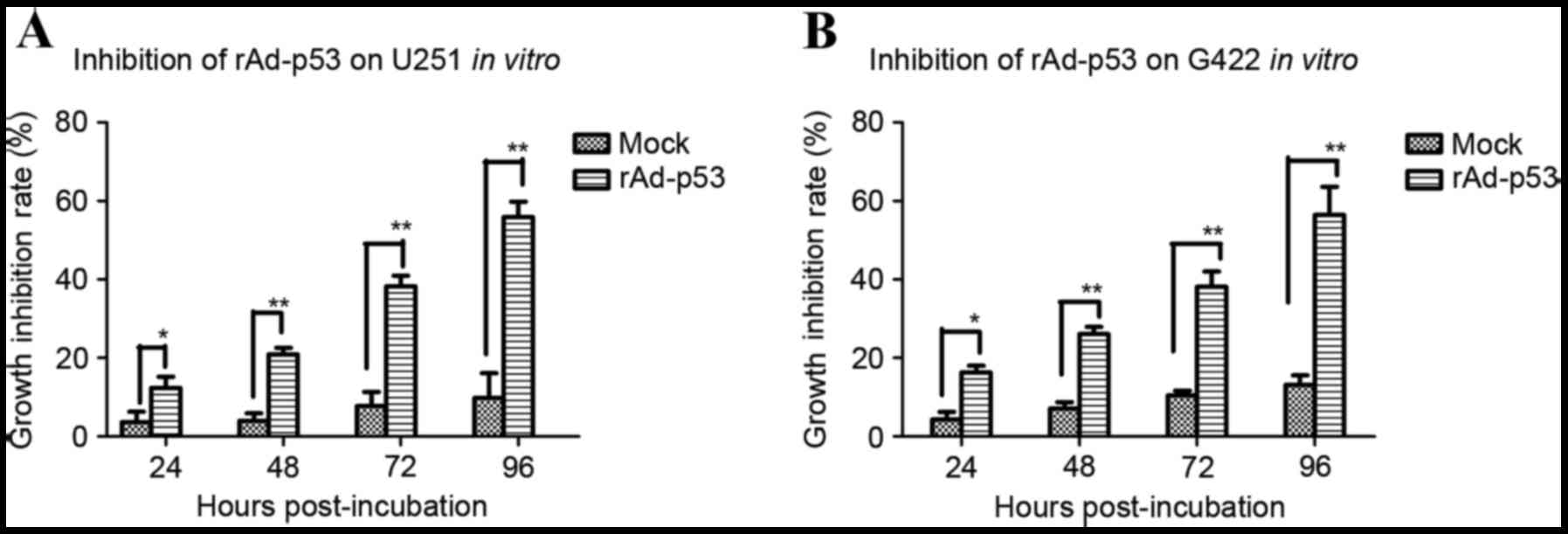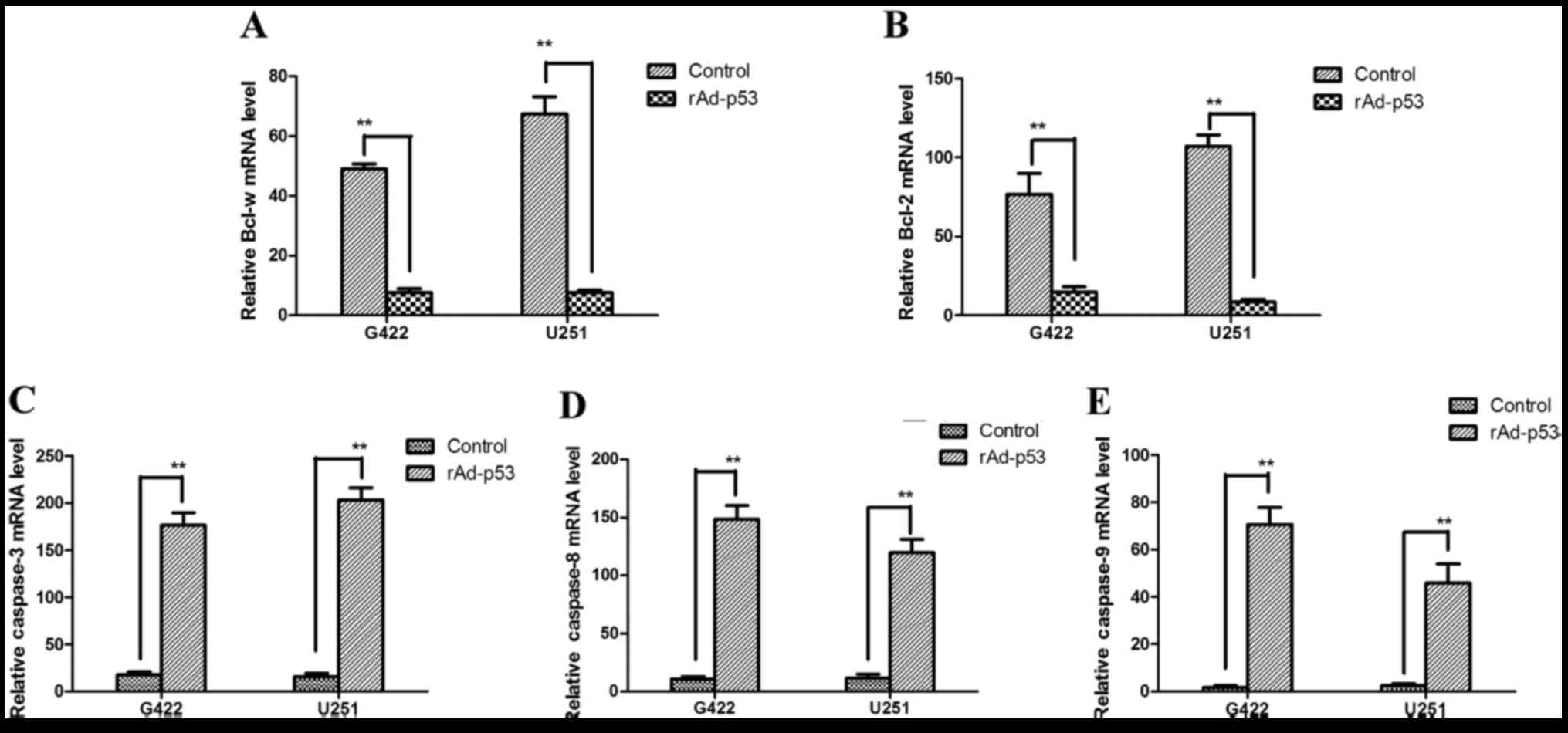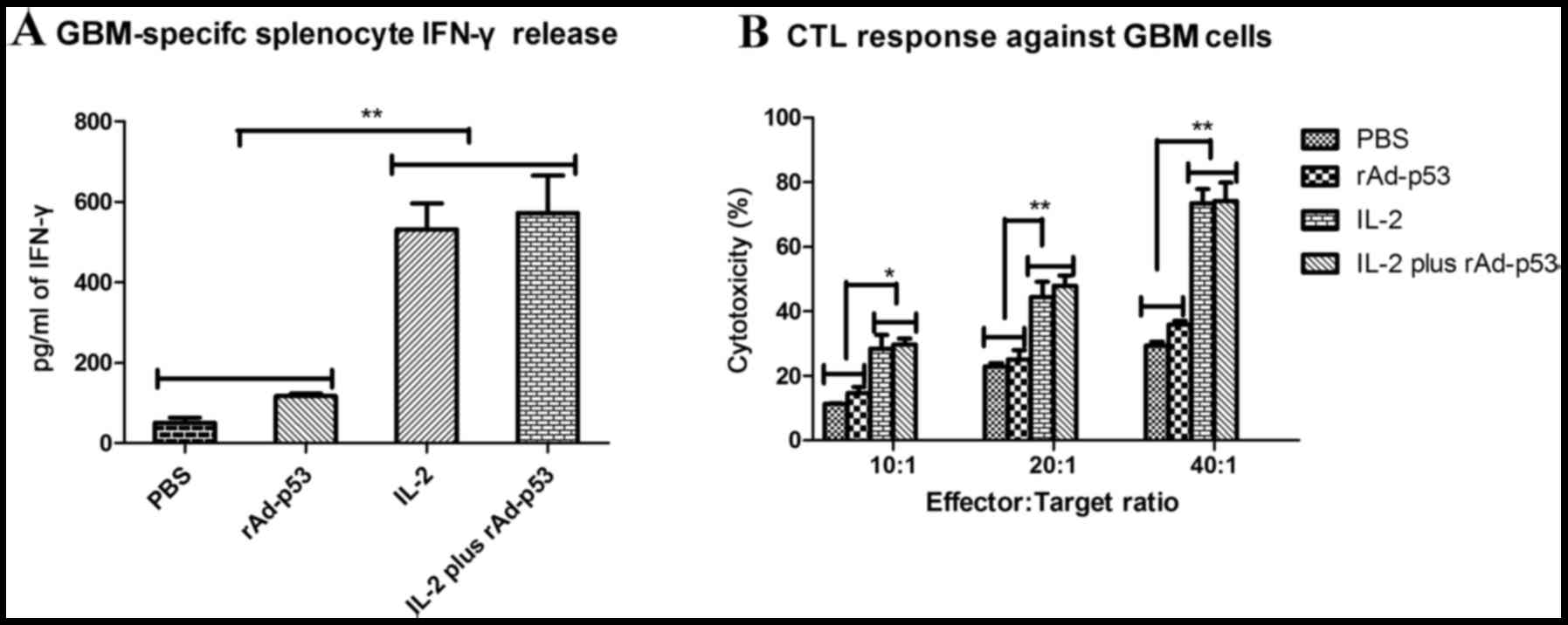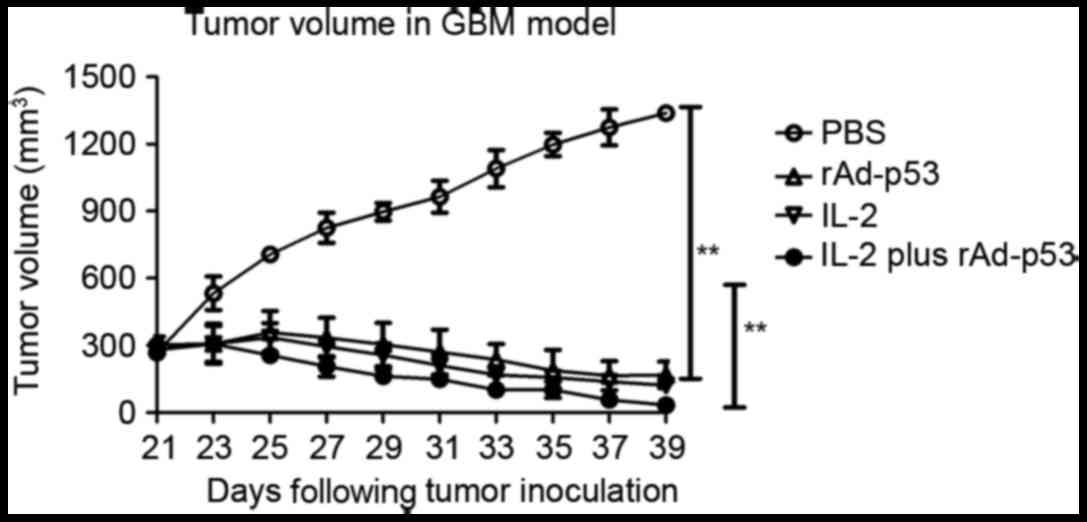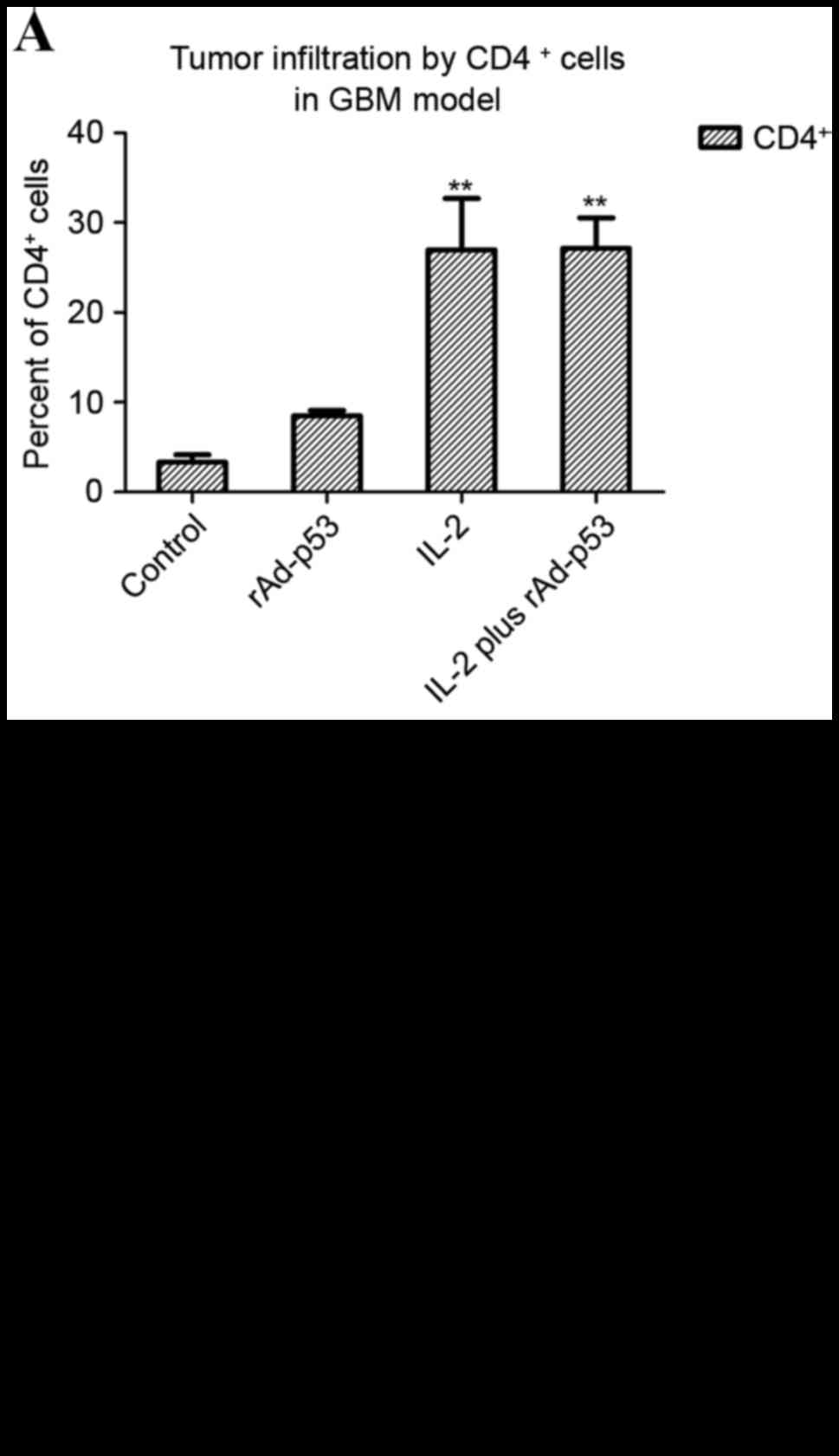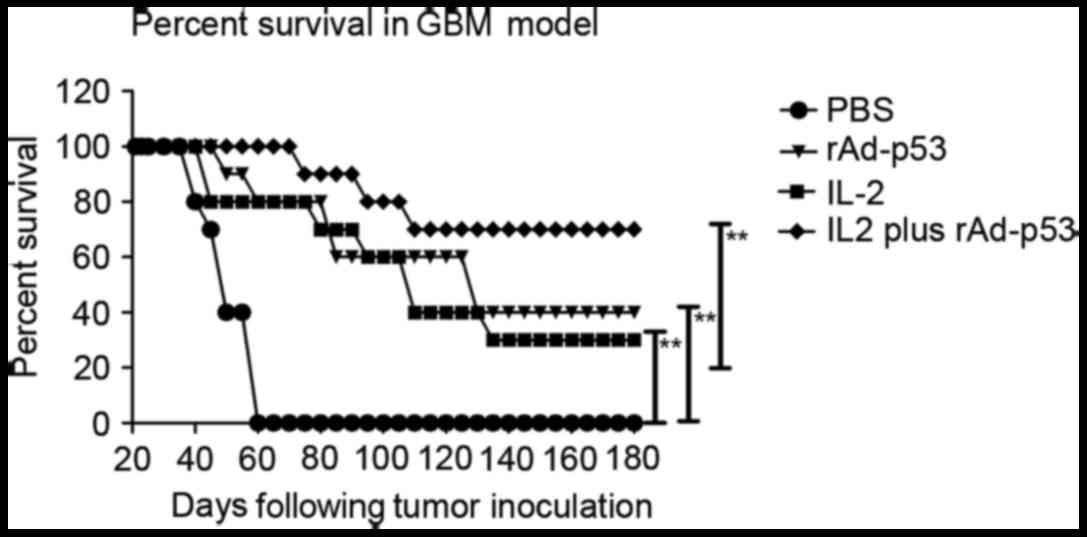The effects of interleukin 2 and rAd-p53 as a treatment for glioblastoma
- Authors:
- Published online on: January 9, 2018 https://doi.org/10.3892/mmr.2018.8408
- Pages: 4853-4859
Abstract
Introduction
Glioblastoma (GBM) is the most aggressive primary brain tumor, originating from the glial cells in adults (1,2). Patients with GBM often present with seizures, which increases the difficulty of treatment. Previous studies have reported that GBM accounts for ~75% in all malignant tumors in the brain (1–3). According to pathological evaluations of GBM malignancy, the World Health Organization categorized GBM into 4 grades. GBM demonstrates infiltrative growth, and different malignant grades result in diverse tumor morphology (3). Therefore, developing effective therapeutic strategies for the treatment of patients with glioblastoma is imperative.
Interleukin (IL)-2 is a pleiotropic cytokine which exerts important effects on cells of the innate and adaptive immune systems (4). IL-2 was the first effective immunotherapeutic approved by the US Food and Drug Administration for metastatic melanoma (5), and is involved in T-cell activation and effector functions, including T-cell proliferation, interferon (IFN)-γ production and cytotoxicity (6). IL-2 stimulates the propagation of lymphocytes and induces cytotoxic T lymphocytes (CTL) and lymphokine-activated killer cells in response to multiple tumor cells (7). IL-2 also influences homeostasis of memory T cells through the regulation of their numbers, and drives the generation of antigen-specific T cells, promoting the survival of memory CD8+ T cells (8). Therefore, it has been used for cancer immunotherapy. It has previously been reported that IL-2 enhances the therapeutic effects of other anti-cancer agents though stimulating the immune system to produce tumor-specific immune cells that attack the tumors (9).
The p53 protein is encoded by the tumor protein p53 gene (TP53) which is a tumor suppressor gene involved in the regulation of the cell cycle, apoptosis, cell differentiation and other mechanisms of cell regulation during exposure to DNA-damaging agents, including ultraviolet radiation and toxins (10). GBM occurrence is closely associated with p53 mutations (11,12). These mutations appear to be the most common genetic change observed in human cancer (13–15). Alteration or inactivation of p53 by mutation, or through its interactions with oncogenic products of DNA tumor viruses, may result in cancer (16). TP53 has become a focus in cancer research because it is commonly mutated in human cancer, and the spectrum of p53 mutations in these cancers may enhance understanding of the etiology and molecular pathogenesis of neoplasia (17,18). Detection of p53 abnormalities may have diagnostic, prognostic, and therapeutic implications (19,20). It has previously been demonstrated that p53 mutations are important to the classification of gliomas (10). In GBM, mutations of p53 primarily occur in the DNA-binding domain within 6 mutation hotspot sites (21). Non-pathogenic mutations of p53 that protect against neoplastic transformation affect modulation of the cell cycle, DNA repair, apoptosis, senescence, angiogenesis and metabolism, resulting in a complex signaling network (20,22). However, the therapeutic effect of p53 in GBM remains to be elucidated.
In the present study, murine models of GBM were used to study the therapeutic effects of p53 combined with the immunomodulator IL-2. Although the use of p53 as a molecular marker for GBM remains controversial, with studies failing to demonstrate an association with prognosis, improvement was observed in patients with cancer following transfection with a replication-defective recombinant adenoviral vector encoding p53 (rAd-p53) (23,24). p53-targeted gene therapy for GBM has reached phase I clinical trials, while therapeutic drugs remain in preclinical development. The aim of the present study was to examine the impact of p53 on GBM cell apoptosis, disease prognosis, and the impact and immunoregulatory function of IL-2 on lymphocyte infiltration, toxicity and immunological memory in GBM. The results of the present study may be a useful reference for GBM treatment, providing insight into the pathophysiology of the disease, and may assist in the development of treatments for GBM.
Materials and methods
Ethical statement
The present study was performed in strict accordance with the recommendations of the Guide for the Care and Use of Laboratory Animals of the National Institutes of Health (Bethesda, MD, USA) (25). The protocol was approved by the Chinese Association for Laboratory Animal Sciences, Animal Health Products, and the Committee on the Ethics of Animal Experiments Defense Research. All surgery and euthanasia were performed under sodium pentobarbital (Sigma-Aldrich; Merck KGaA, Darmstadt, Germany) anesthesia, and all efforts were made to minimize suffering.
Animal experiments
Male BALC/c GBM mice (age, 2 months; weight, 30–35 g; n=100) were purchased from the West China Experimental Animal Center of Sichuan University (Sichuan, China). Mice were housed in a temperature-controlled facility at 23±1°C and relative humidity 50±5%, with a 12-h light/dark cycle and had free access to food and water. Mice were randomly assigned to the following 4 groups (n=25 mice/group): rAD-p53 group, rAd-p53 + IL-2 group, IL-2 group and control group. Each mouse in the treatment groups received an intratumoral injection of 100 µl rAd-p53 (Gendicine; Shenzhen SiBiono GeneTech Co., Ltd., Shenzhen, China) and/or an intravenous injection of 0.2 mg IL-2 once daily, administered continuously in 7-day cycles. The mice in the control groups received normal saline intravenously, serving as an injection control. Tumor dimensions were measured every 2 days and 10 times in total. The tumor volumes were calculated according to the following formula: Length × width2 × 0.52. At the final point of measurement, the tumor diameters were ~10–12 mm. On day 39 following the first inoculation, the tumors were used for reverse transcription-quantitative polymerase chain reaction (RT-qPCR) analysis.
Cell culture and reagents
U251 and G422GBMcell lines were obtained from the National Cancer Institute, Frederick Cancer Research Facility, Division of Cancer Treatment Tumor Repository (Frederick, MD, USA) and the American Type Culture Collection (Manassas, VA, USA), respectively. The U251 or G422 cells were cultured in RPMI-1640 or Eagle's minimum essential medium, respectively, supplemented with 10% heat-inactivated fetal bovine serum (Biowhittaker; Lonza Group, Basel, Switzerland), 3 mM L-glutamine, 50 µg/ml gentamicin (Biowhittaker; Lonza Group) and 1% penicillin/streptomycin. Normal human astrocyte cells were purchased from Clonetics (Biowhittaker; Lonza Group), and maintained in an astrocyte growth medium bullet kit from the same supplier.
MTT cytotoxicity assays
The U251 or G422 cells (1×104 cells) were incubated with 0.1 ml rAd-p53 in 96-well plates for 48, 72 and 96 h in triplicate for each condition, and 0.1 ml phosphate-buffered saline (PBS) was added instead of rAd-p53 as a control. Briefly, 20 µl MTT (5 mg/ml; Merck KGaA) in PBS was added to each well and the plate was further incubated for 4 h at 37°C. Most of the medium was removed and 100 µl dimethylsulfoxide (Sigma-Aldrich; Merck KGaA) was added into the wells to solubilize the crystals. The optical density was measured using a microplate reader (Bio-Rad Laboratories, Inc., Hercules, CA, USA) at a wavelength of 450 nm. The following formula was used: Percentage cell viability = [(absorbance of untreated cells - absorbance of treated cells)/absorbance of untreated cells] × 100.
Flow cytometry analysis (FACS)
Tumor samples were minced to obtain single-cell suspensions. Tumor cell suspensions were then diluted to 10×106 cells/ml, and centrifuged at 1,000 × g for 5 min at 4°C. Cells were treated with 200 µl freshly prepared cold fixation buffer (Merck KGaA) for 30 min at 4°C in the dark. Then, samples were centrifuged at 1,000 × g for 5 min at 4°C and the cell pellet was suspended in 200 µl freshly prepared pre-warmed (37°C) permeabilization buffer (Haoran Bioscience, Inc., Shanghai, China). Following incubation for 30 min at 37°C in the dark, cells were centrifuged at 1,000 × g for 5 min at 4°C, washed with 200 µl PBS, centrifuged at 1,000 × g for 5 min at 4°C and the supernatant was discarded. Then, the tumor cells were labeled with CD3 (ab16669; 1:1,500; Abcam, Cambridge, UK), CD45 (ab10558; 1:1,500; Abcam), CD4 (ab183685; 1:2,000; Abcam) and CD8 (ab4055; 1:2,000; Abcam) at room temperature in the dark for 30 min to detect the frequency of CD4 and CD8 cell subsets in the total infiltrated immune cells. Horseradish peroxidase-conjugated anti-rabbit IgG (1706515, Bio-Rad, Hercules, CA, USA) was used at a 1:5,000 dilution for 1 h at 37°C. The stained cells were analyzed using a BD FACScan flow cytometer (BD Biosciences, Franklin Lakes, NJ, USA) and WinMDI software version 2.9 (The Scripps Institute, La Jolla, CA).
Splenocyte collection and CTL assays
Spleens were removed from euthanized animals and splenocytes were isolated by passing the spleens through 100 µm nylon mesh filters. Cells were stimulated with 50 ng/ml paramethoxyamphetamine (PMA; Sigma-Aldrich; Merck KGaA) and 1 µg/ml ionomycin (Sigma-Aldrich; Merck KGaA) in the presence of BD Golgistop protein transport inhibitor (BD Biosciences) in complete RPMI-1640 medium (Sigma-Aldrich; Merck KGaA). The cells were then diluted to 1×105 cells/ml in RPMI-1640, and centrifuged at 1,000 × g for 5 min and the supernatant was removed. The cells (1×105/well) were washed with PBS and incubated with mitomycin-inactivated G422 cells (splenocyte:G422 ratios of 10:1, 20:1 and 40:1). IFN-γ levels were measured in the supernatants on day 3 using a sandwich ELISA kit (cat. no. ab174443; Abcam). In addition, T cells (1×106 cells/well) from the splenocytes were purified as previously described (26) and co-cultured in RPMI-1640 medium with fresh G422 cells for 4 h at effector:target ratios of 10:1, 20:1 and 40:1. Specific CTL activity to the target cells was determined by MTT cytotoxicity assays as previously described (27).
Measurement of relative mRNA expression levels by RT-qPCR
Total cellular RNA was extracted using an RNeasy mini kit (Qiagen, Inc., Valencia, CA, USA) and 1 µg RNA was subjected to a cDNA using reverse transcription kit (1708840; Bio-Rad Laboratories, Inc.) according to manufacturer's protocol. The resultant cDNA (10 µl) was subjected to a 25 µl PCR conducted in an iCycler thermal cycler (Bio-Rad Laboratories, Inc.) using iQ SYBR-Green Supermix (Bio-Rad Laboratories, Inc.). The thermocycling conditions were as follows: Initial denaturation at 95°C for 5 min, followed by 35 cycles at 95°C for 20 sec, at 58°C for 20 sec and at 72°C for 20 sec, with a final extension at 72°C for 5 min. β-actin was used as the internal reference gene. The relative expression levels were calculated using the comparative Cq method (28), and gene expression was normalized to β-actin. The primers used in the present study were: B-cell lymphoma (Bcl)-2 forward, 5′-CAAAGGTGGATCAGATTCAAG-3′ and reverse, 5′-GGTGAGCATTATCACCCAGAA-3′; Bcl-2 like 2 (Bcl-w) forward, 5′-TGGCAGCAGTGACAGCAGCG-3′ and reverse, 5′-TACGGAGGTGGAGTGGGTGT-3′; caspase-3 forward, 5′-AAAGTTTTCAATGACCAAGC-3′ and reverse, 5′-TCTGACGAATCTCCTCCAC-3′; caspase-8 forward, 5′-AGTCTATTTTATTATGGGCTCG-3′ and reverse, 5′-TGGATGTTTATGTCACCTTTTC-3′; caspase-9 forward, 5′-ATGGAGAACACTGAAAACTC-3′ and reverse, 5′-TGTGAGCATGGAAACAATAC-3′; and β-actin forward, 5′-AGCCTTCTCCATGGTCGTGA-3′ and reverse 5′-CGGAGTCAACGGATTTGGTC-3′. Primers were synthesized by Invitrogen; Thermo Fisher Scientific, Inc. (Waltham, MA, USA).
Statistical analysis
All data were expressed as the mean ± standard error of 3 independent experiments. Statistical analysis was performed using SPSS software version 13.0 (SPSS, Inc., Chicago, IL, USA). The statistical significance of differences between groups was assessed using unpaired Student's t-tests for pair-wise comparisons or one-way analysis of variance followed by a post hoc Student-Newman-Keuls test for multiple comparisons. P<0.05 was considered to indicate a statistically significant difference.
Results
rAd-p53 induces apoptosis in GBM in vitro
In order to explore whether transfection with rAd-p53 effectively induces apoptosis in GBM cells in vitro, the effect of rAd-p53 transfection on human G422 and U251 and murine GBM cells was measured. The apoptosis rate significantly increased in U251 cells transfected with rAd-p53 compared with control cells at 24 (P<0.05; Fig. 1A), 48 (P<0.01; Fig. 1A), 72 (P<0.01; Fig. 1A) and 96 h (P<0.01; Fig. 1A) post-incubation. Similar effects were observed in G422 cells, with significantly increased apoptosis rates in cells transfected with rAd-p53 compared with control cells at 24 (P<0.05; Fig. 1B), 48 (P<0.01; Fig. 1B), 72 (P<0.01; Fig. 1B) and 96 h (P<0.01; Fig. 1B) post-incubation.
Apoptosis-associated gene expression levels from cells transfected with rAd-p53 were measured in vivo by RT-qPCR, including the apoptosis regulator Bcl-2, Bcl-w, caspase-8, caspase-3, and caspase-9. mRNA expression levels of the apoptosis-inhibiting genes Bcl-w and Bcl-2 were significantly decreased in cells transfected with rAd-p53 compared with controls (G422, P<0.01 and P<0.01, respectively; Fig. 2A and B, respectively; U251, P<0.01 and P<0.01, respectively; Fig. 2A and B, respectively), and mRNA expression levels of the pro-apoptotic genes caspase-8, caspase-3, and caspase-9 were significantly increased in cells transfected with rAd-p53 compared with control cells (G422, P<0.01, P<0.01 and P<0.01, respectively; Fig. 2C-E, respectively; U251, P<0.01, P<0.01 and P<0.01, respectively; Fig. 2C-E, respectively). These results suggest that rAd-p53 induces apoptosis by inhibiting the activation of Bax and Bcl-2, and that GBM is inhibited by the mitochondrial-dependent apoptosis pathway.
IL-2 invokes cytotoxicity in a murine GBM model
To confirm that IL-2-treated mice develop an adaptive immune response to the tumor cells, GBM model mice were sacrificed on day 39 and assessed for the development of CTL responses against the tumor cells. GBM-specific CTL activity was assessed following the purification of T cells co-cultured with tumor cells. Treatment with IL-2 resulted in increased IFN-γ release when compared with control groups (Fig. 3A). CTL activity was significantly increased in cells treated with IL-2 only compared with cells treated with PBS or rAd-p53 only at all three effector:target ratios investigated (10:1, P<0.05 and P<0.05, respectively; 20:1, P<0.01 and P<0.01, respectively; 40:1, P<0.01 and P<0.01, respectively; Fig. 3B), and a similar effect was observed in cells treated with IL-2 and rAd-p53, with CTL activity significantly increased compared with cells treated with PBS or rAd-p53 only (10:1, P<0.05 and P<0.05, respectively; 20:1, P<0.01 and P<0.01, respectively; 40:1, P<0.01 and P<0.01, respectively; Fig. 3B). These results suggested that the treatment of tumors with IL-2 may result in the generation of tumor-specific CTL responses.
In vivo rAd-p53 and IL-2 enhanced treatment of GBM
To explore rAd-p53 and IL-2 function as effective anti-cancer agents in vivo, the anti-tumor activity of rAd-p53 and IL-2 was investigated in the syngeneic murine GBM model. Mice were randomly selected from each group (6/10) to measure the tumor size. Mice (n=60) were sacrificed for further analysis on day 39 following tumor implantation, while the remaining animals (n=40) continued to be monitored for tumor growth and survival until day 180. Tumor size in the animals treated with rAd-p53 and IL-2 was significantly smaller than that in the mice treated with PBS (P<0.0001; Fig. 4) or mice treated with the single agents IL-2 (P=0.0084; Fig. 4) and rAd-p53 (P<0.0038; Fig. 4).
Treatment of IL-2 results in immune cell accumulation in GBM tumors
Tumors from the sacrificed mice from the late treatment group described above were collected on day 25, dissected, filtered, and stained for CD4+ and CD8+ expression. Tumors from the animals treated with rAd-p53 and IL-2 or IL-2 exhibited a high degree of both CD4+ (Fig. 5A) and CD8+ (Fig. 5B) cell infiltration in both tumor models, as determined by Student's paired t-tests. These observations suggested that the IL-2 or rAd-p53 and IL-2-treated animals developed a stronger immune response to the tumor.
Treatment of rAd-p53 and IL-2 results in survival prolongation in GBM mice
rAd-p53 and IL-2-treated mice maintained the highest survival rate, suggesting that IL-2 has good therapeutic effects for GBM. Furthermore, long-term survival was monitored for 180 days following treatment with TNF-α and lenvatinib. rAd-p53 and IL-2 (n=10 in each group) prolonged the survival of mice compared with control groups (Fig. 6). These results indicated that the therapeutic agents against GBM in the rAd-p53 plus IL-2 group were strong enough to partially protect the animals and partially eliminate the tumor cells, which translated into long-term and tumor-free survival.
Discussion
Immunotherapy has demonstrated marked antitumor activity when associated with other therapeutic methods in animal models of several types of human cancer (29–31). Antineoplastic agents used in combination with immunotherapy effectively target tumor cell-specific recognition domains (antigens or receptors) (32–35). At present, multiple immunotherapy agents for cancer are being tested clinically. Immunotherapy agents, in which an antibody or interleukin is inserted into a vector, have demonstrated encouraging results in the treatment of certain advanced tumors in patients (36). Recombinant adenovirus with inserted p53 protein (rAd-p53) additionally demonstrates marked antitumor activity in patients with T-cell lymphoma and melanoma (37). For cervical cancer, 1 simian and 10 human adenovirus serotypes were administered to 30 patients, resulting in necrosis and transient tumor regression in certain patients (34). Yoshida et al (37) reported that generation of fiber-mutant recombinant adenovirus for gene therapy to treat malignant GBM demonstrates impressive antitumor activity by intratumor administration of anti-cancer agents targeted to tumor cells. Furthermore, Chen et al (23) investigated the potential antitumor effects of rAd-p53 by enhancing the sensitivity of gastric cancer cells to chemotherapy, suggesting that rAd-p53 is an ideal anti-cancer agent for cancer therapy.
IL-2 has been demonstrated to possess antitumor activity in human cancer therapy in previous studies (38,39). IL-2 was well tolerated without apparent indication of drug-associated toxicity. As targeted therapy provides the advantage of tumor specificity, it is conceivable that effectively invoking the toxicity of immune cells for tumor cells may be useful for GBM tumor therapy. The application of IL-2 would be either peritumoral application or intravenous injection. These forms of application would aim at producing tumor-specific killer cells with improved immunogenicity to stimulate adaptive T cell mediated anti-tumor immunity (40). This concept is corroborated by the importance IL-2 signals have for priming and secondary expansion of memory T cells (41). The best long-term anti-tumor effects would be expected from T cells, which have specificity for tumor-associated antigens including memory T cells, CD4 helper T cells and CD8 cytotoxic T cells. Furthermore, CD8 T cells are an essential part of the adaptive immune system against intracellular pathogens and cancerous growths.
In the present study, GBM tumors treated with IL-2 and rAd-p53 stimulated T cells from the immune system in addition to T cells from patients with cancer in vitro, however, they also induced apoptosis of GBM cells via the caspase signaling pathway. In the first case, GBM mice stimulated by injection of IL-2 demonstrated significantly increased numbers of CD4 and CD8 T cells expressing the early activation marker CD69 and producing IFN-γ. In the latter case, IL-2 was used to stimulate T cells isolated from patient-derived lymph nodes. T cells from cancer patients activated by IL-2 demonstrated positive therapeutic effects. For example, the response was tumor-specific by the same tumor cells, suggesting that autologous tumor antigens had to be present in the assay to generate a memory response (42). Finally, GBM tumor cells were significantly inhibited by apoptosis of the mitochondrial signaling pathway. The abilities of IL-2 and rAd-p53 may have been based on tumor-specific memory T cells, apoptosis was induced by the mitochondrial signaling pathway, and was augmented when IL-2 provided further signals.
In conclusion, GBM mice treated with IL-2 and rAd-p53 were studied and demonstrated potent antitumor activity against GBM and GBM-initiating cells in vitro. They induced the regression of established GBM xenografts in vivo, indicating that they may be of value for the treatment of GBM.
References
|
Lu M, Zhang X, Zhang M, Chen H, Dou W, Li S and Dai J: Non-model segmentation of brain glioma tissues with the combination of DWI and fMRI signals. Biomed Mater Eng. 26 Suppl 1:S1315, 2015–S1324. 2015. | |
|
Chow KK, Naik S, Kakarla S, Brawley VS, Shaffer DR, Yi Z, Rainusso N, Wu MF, Liu H, Kew Y, et al: T cells redirected to EphA2 for the immunotherapy of glioblastoma. Mol Ther. 21:629–637. 2013. View Article : Google Scholar : PubMed/NCBI | |
|
Koekkoek JA, Postma TJ, Heimans JJ, Reijneveld JC and Taphoorn MJ: Antiepileptic drug treatment in the end-of-life phase of glioma patients: A feasibility study. Support Care Cancer. 24:1633–1638. 2016. View Article : Google Scholar : PubMed/NCBI | |
|
Bai FL, Tian H, Yu QZ, Renl GP and Li DS: Expressing foreign genes by Newcastle disease virus for cancer therapy. Mol Biol (Mosk). 49:195–204. 2015. View Article : Google Scholar : PubMed/NCBI | |
|
Snyder A, Zamarin D and Wolchok JD: Immunotherapy of Melanoma. Prog Tumor Res. 42:22–29. 2015.PubMed/NCBI | |
|
Bai FL, Yu YH, Tian H, Ren GP, Wang H, Zhou B, Han XH, Yu QZ and Li DS: Genetically engineered Newcastle disease virus expressing interleukin-2 and TNF-related apoptosis-inducing ligand for cancer therapy. Cancer Biol Ther. 15:1226–1238. 2014. View Article : Google Scholar : PubMed/NCBI | |
|
Shi L, Zhou Q, Wu J, Ji M, Li G, Jiang J and Wu C: Efficacy of adjuvant immunotherapy with cytokine-induced killer cells in patients with locally advanced gastric cancer. Cancer Immunol Immunother. 61:2251–2259. 2012. View Article : Google Scholar : PubMed/NCBI | |
|
Chen Y, Guo ZQ, Shi CM, Zhou ZF, Ye YB and Chen Q: Efficacy of adjuvant chemotherapy combined with immunotherapy with cytokine-induced killer cells for gastric cancer after d2 gastrectomy. Int J Clin Exp Med. 8:7728–7736. 2015.PubMed/NCBI | |
|
Lippitz BE: Cytokine patterns in patients with cancer: A systematic review. Lancet Oncol. 14:e218–e228. 2013. View Article : Google Scholar : PubMed/NCBI | |
|
Karsy M, Neil JA, Guan J, Mahan MA, Colman H and Jensen RL: A practical review of prognostic correlations of molecular biomarkers in glioblastoma. Neurosurg Focus. 38:E42015. View Article : Google Scholar : PubMed/NCBI | |
|
Yamanishi Y, Boyle DL, Green DR, Keystone EC, Connor A, Zollman S and Firestein GS: p53 tumor suppressor gene mutations in fibroblast-like synoviocytes from erosion synovium and non-erosion synovium in rheumatoid arthritis. Arthritis Res Ther. 7:R12–R18. 2005. View Article : Google Scholar : PubMed/NCBI | |
|
Ohgaki H, Eibl RH, Schwab M, Reichel MB, Mariani L, Gehring M, Petersen I, Höll T, Wiestler OD and Kleihues P: Mutations of the p53 tumor suppressor gene in neoplasms of the human nervous system. Mol Carcinog. 8:74–80. 1993. View Article : Google Scholar : PubMed/NCBI | |
|
Sakai E, Rikimaru K, Ueda M, Matsumoto Y, Ishii N, Enomoto S, Yamamoto H and Tsuchida N: The p53 tumor-suppressor gene and ras oncogene mutations in oral squamous-cell carcinoma. Int J Cancer. 52:867–872. 1992. View Article : Google Scholar : PubMed/NCBI | |
|
Greenblatt MS, Bennett WP, Hollstein M and Harris CC: Mutations in the p53 tumor suppressor gene: Clues to cancer etiology and molecular pathogenesis. Cancer Res. 54:4855–4878. 1994.PubMed/NCBI | |
|
Rivlin N, Brosh R, Oren M and Rotter V: Mutations in the p53 tumor suppressor gene: Important milestones at the various steps of tumorigenesis. Genes Cancer. 2:466–474. 2011. View Article : Google Scholar : PubMed/NCBI | |
|
Yue Q, Yulong G, Liting Q, Shuai Y, Delong L, Yubao L, Lili J, Sidang L and Xiaomei W: Mutations in and expression of the tumor suppressor gene p53 in egg-type chickens infected with subgroup J avian leukosis virus. Vet Pathol. 52:1052–1066. 2015. View Article : Google Scholar : PubMed/NCBI | |
|
Hollstein M, Sidransky D, Vogelstein B and Harris CC: p53 mutations in human cancers. Science. 253:49–53. 1991. View Article : Google Scholar : PubMed/NCBI | |
|
Hamzehloie T, Mojarrad M, Hasanzadeh Nazarabadi M and Shekouhi S: The role of tumor protein 53 mutations in common human cancers and targeting the murine double minute 2-p53 interaction for cancer therapy. Iran J Med Sci. 37:3–8. 2012.PubMed/NCBI | |
|
Fagin JA: Tumor suppressor genes in human thyroid neoplasms: p53 mutations are associated undifferentiated thyroid cancers. J Endocrinol Invest. 18:140–142. 1995. View Article : Google Scholar : PubMed/NCBI | |
|
Harris CC and Hollstein M: Clinical implications of the p53 tumor-suppressor gene. N Engl J Med. 329:1318–1327. 1993. View Article : Google Scholar : PubMed/NCBI | |
|
Casson AG, Evans SC, Gillis A, Porter GA, Veugelers P, Darnton SJ, Guernsey DL and Hainaut P: Clinical implications of p53 tumor suppressor gene mutation and protein expression in esophageal adenocarcinomas: Results of a ten-year prospective study. J Thorac Cardiovasc Surg. 125:1121–1131. 2003. View Article : Google Scholar : PubMed/NCBI | |
|
Kuczyk MA, Serth J, Hervatin C, Arndt H, Derendorf L, Thon WF and Jonas U: Detection of p53 tumor-suppressor-gene protein in bladder tumors and prostate cancer: Possible clinical implications. World J Urol. 12:345–351. 1994. View Article : Google Scholar : PubMed/NCBI | |
|
Chen GX, Zheng LH, Liu SY and He XH: rAd-p53 enhances the sensitivity of human gastric cancer cells to chemotherapy. World J Gastroenterol. 17:4289–4297. 2011. View Article : Google Scholar : PubMed/NCBI | |
|
Xie Q, Liang BL, Wu YH, Zhang J, Chen MW, Liu HY, Gu XF and Xu J: Synergistic anticancer effect of rAd/P53 combined with 5-fluorouracil or iodized oil in the early therapeutic response of human colon cancer in vivo. Gene. 499:303–308. 2012. View Article : Google Scholar : PubMed/NCBI | |
|
National Research Council (US) Committee for the Update of the Guide for the Care and Use of Laboratory Animals: Guide for the Care and Use of Laboratory Animals. 8th. National Academies Press (US); Washington, DC: 2011 | |
|
Greaves MF and Brown G: Purification of human T and B lymphocytes. J Immunol. 112:420–423. 1974.PubMed/NCBI | |
|
Zamarin D, Vigil A, Kelly K, Garcia-Sastre A and Fong Y: Genetically engineered Newcastle disease virus for malignant melanoma therapy. Gene Ther. 16:796–804. 2009. View Article : Google Scholar : PubMed/NCBI | |
|
Livak KJ and Schmittgen TD: Analysis of relative gene expression data using real-time quantitative PCR and the 2(-Delta Delta C(T)) method. Methods. 25:402–408. 2001. View Article : Google Scholar : PubMed/NCBI | |
|
Thomas AA, Ernstoff MS and Fadul CE: Immunotherapy for the treatment of glioblastoma. Cancer J. 18:59–68. 2012. View Article : Google Scholar : PubMed/NCBI | |
|
Larsen CJ: Cellular immunotherapy and glioblastoma: A hopeful treatment? Bull Cancer. 98:4572011.PubMed/NCBI | |
|
Varghese S, Rabkin SD, Nielsen GP, MacGarvey U, Liu R and Martuza RL: Systemic therapy of spontaneous prostate cancer in transgenic mice with oncolytic herpes simplex viruses. Cancer Res. 67:9371–9379. 2007. View Article : Google Scholar : PubMed/NCBI | |
|
Husain SR, Behari N, Kreitman RJ, Pastan I and Puri RK: Complete regression of established human glioblastoma tumor xenograft by interleukin-4 toxin therapy. Cancer Res. 58:3649–3653. 1998.PubMed/NCBI | |
|
Debinski W, Gibo DM, Obiri NI, Kealiher A and Puri RK: Novel anti-brain tumor cytotoxins specific for cancer cells. Nat Biotechnol. 16:449–453. 1998. View Article : Google Scholar : PubMed/NCBI | |
|
Bera TK, Viner J, Brinkmann E and Pastan I: Pharmacokinetics and antitumor activity of a bivalent disulfide-stabilized Fv immunotoxin with improved antigen binding to erbB2. Cancer Res. 59:4018–4022. 1999.PubMed/NCBI | |
|
Ghetie MA, Richardson J, Tucker T, Jones D, Uhr JW and Vitetta ES: Antitumor activity of Fab' and IgG-anti-CD22 immunotoxins in disseminated human B lymphoma grown in mice with severe combined immunodeficiency disease: Effect on tumor cells in extranodal sites. Cancer Res. 51:5876–5880. 1991.PubMed/NCBI | |
|
Sinkovics JG and Horvath JC: Natural and genetically engineered viral agents for oncolysis and gene therapy of human cancers. Arch Immunol Ther Exp (Warsz). 56 Suppl 1:3S–59S. 2008. View Article : Google Scholar : PubMed/NCBI | |
|
Yoshida Y, Sadata A, Zhang W, Saito K, Shinoura N and Hamada H: Generation of fiber-mutant recombinant adenoviruses for gene therapy of malignant glioma. Hum Gene Ther. 9:2503–2515. 1998. View Article : Google Scholar : PubMed/NCBI | |
|
Kusnierczyk H, Pajtasz-Piasecka E, Koten JW, Bijleveld C, Krawczyk K and Den Otter W: Further development of local IL-2 therapy of cancer: Multiple versus single IL-2 treatment of transplanted murine colon carcinoma. Cancer Immunol Immunother. 53:445–452. 2004. View Article : Google Scholar : PubMed/NCBI | |
|
Pantuck AJ and Belldegrun AS: Phase I clinical trial of interleukin 2 (IL-2) gene therapy for prostate cancer. Curr Urol Rep. 2:332001. View Article : Google Scholar : PubMed/NCBI | |
|
Baek S, Kim YM, Kim SB, Kim CS, Kwon SW, Kim Y, Kim H and Lee H: Therapeutic DC vaccination with IL-2 as a consolidation therapy for ovarian cancer patients: A phase I/II trial. Cell Mol Immunol. 12:87–95. 2015. View Article : Google Scholar : PubMed/NCBI | |
|
Tan Y, Xu M, Wang W, Zhang F, Li D, Xu X, Gu J and Hoffman RM: IL-2 gene therapy of advanced lung cancer patients. Anticancer Res. 16:1993–1998. 1996.PubMed/NCBI | |
|
Gilly FN, Beaujard A, Bienvenu J, Trillet Lenoir V, Glehen O, Thouvenot D, Malcus C, Favrot M, Dumontet C, Lombard-Bohas C, et al: Gene therapy with Adv-IL-2 in unresectable digestive cancer: Phase I–II study, intermediate report. Hepatogastroenterology. 46 Suppl 1:S1268–S1273. 1999. |



